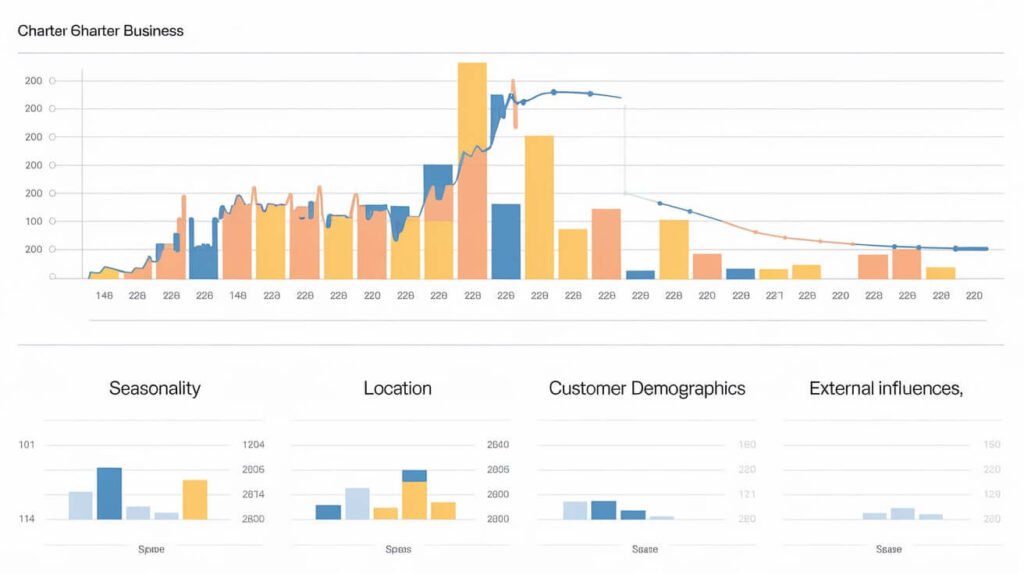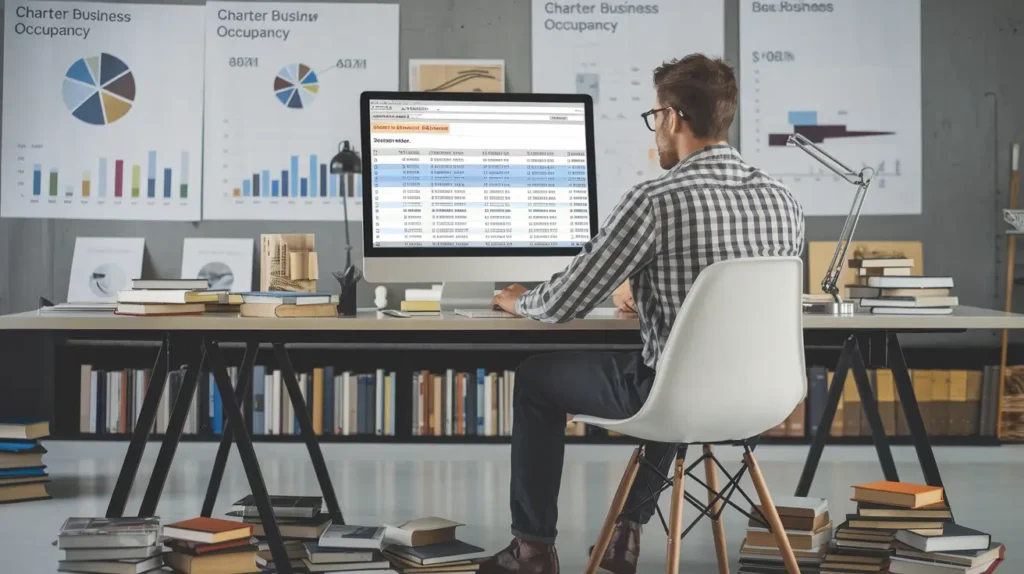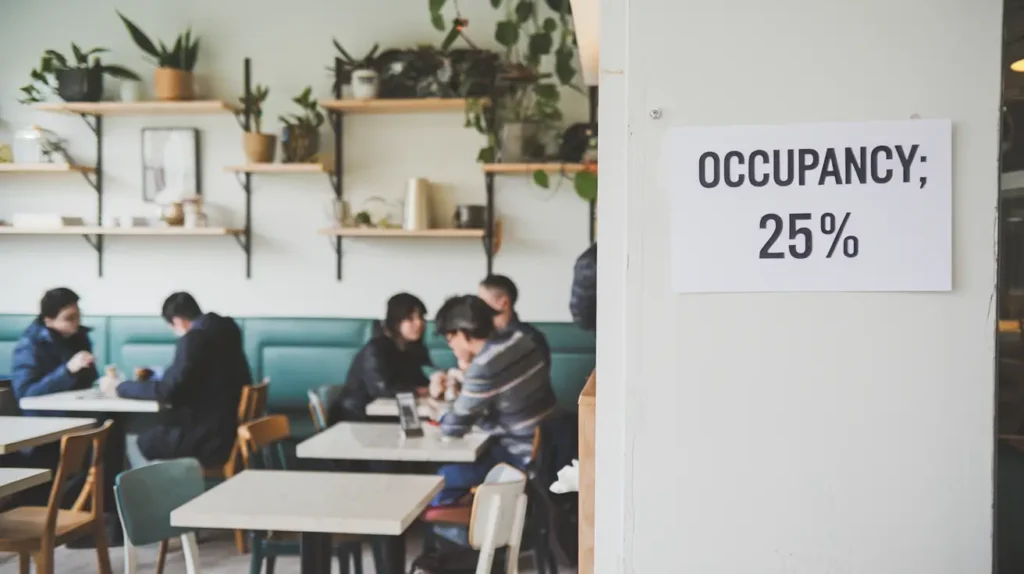How to Calculate Occupancy of a Charter Business? 3 Powerful Steps to Calculate
In the charter business, whether you operate boats, buses, private jets, or other vehicles, occupancy is a crucial metric that directly impacts profitability. Occupancy rate measures the percentage of time a charter asset, like a vehicle or vessel, is booked or utilized within a given period. Calculating and tracking occupancy rates allows business owners to assess operational efficiency, optimize pricing strategies, and make informed business decisions.

This article delves into how to calculate occupancy of a charter business, covering the methods, formulas, and key factors to consider to improve your occupancy rate and maximize profits.
Table of Contents
- Understanding Occupancy Rate in a Charter Business
- Basic Formula to Calculate Occupancy of a Charter Business
- 3 Steps to Calculate Occupancy Rate for Different Charter Types
- Factors Influencing Occupancy Rate in a Charter Business
- Using Occupancy Rate to Set Pricing for a Charter Business
- Tools and Software to Track Occupancy in a Charter Business
- Strategies to Improve Occupancy of a Charter Business
- Analyzing Historical Data to Optimize Charter Business Occupancy
- Calculating Occupancy Rate with Multiple Charter Assets
- Measuring Occupancy for Profitability and Capacity Planning
- Common Mistakes to Avoid When Calculating Occupancy Rate
- What is the Formula for Occupancy?
- How Do You Calculate Occupancy of a Business?
- How to Calculate Occupancy of a Charter Business in Excel
- How to Calculate Occupancy Percentage in Hotel
- Conclusion
- Frequently Asked Questions (FAQs)
- What is the ideal occupancy rate for a charter business?
- How can I increase occupancy in my charter business?
- Which software is best for tracking occupancy in a charter business?
- How does seasonality affect occupancy rate in charter businesses?
- How does occupancy rate impact profitability?
- Can occupancy data help with capacity planning in a charter business?
- How often should I calculate occupancy rates?
- Should I account for maintenance downtime in occupancy calculations?
- Is there a difference between occupancy rate and utilization rate?
- How does occupancy affect customer experience?
Understanding Occupancy Rate in a Charter Business
Occupancy rate in the charter industry is a vital metric that reflects how often your assets (boats, buses, jets, etc.) are utilized within a specific period. In simple terms, it’s the percentage of time your assets are booked versus available. High occupancy rates generally indicate strong demand and efficient asset use, while low occupancy rates can suggest underutilization or potential issues with pricing, marketing, or customer reach.
- Revenue Impact: The occupancy rate directly affects revenue. A higher rate typically results in higher revenue, provided costs are managed.
- Customer Satisfaction and Asset Management: Maintaining an optimal occupancy rate ensures assets aren’t overused, which can lead to wear and tear, or underused, resulting in idle time and reduced profitability. Understanding occupancy enables better planning and asset allocation.

Basic Formula to Calculate Occupancy of a Charter Business
The basic formula for calculating occupancy rate in a charter business is:
Occupancy Rate=(Total Booked Hours or DaysTotal Available Hours or Days)×100\text{Occupancy Rate} = \left( \frac{\text{Total Booked Hours or Days}}{\text{Total Available Hours or Days}} \right) \times 100 Occupancy Rate=(Total Available Hours or DaysTotal Booked Hours or Days)×100
This formula provides the occupancy percentage by dividing the total hours (or days) booked by the total available hours (or days) of operation.
Example Calculation:
If a charter boat is available for 30 days in a month and is booked for 20 days, the occupancy rate calculation would be:
Occupancy Rate=(2030)×100=66.67%\text{Occupancy Rate} = \left( \frac{20}{30} \right) \times 100 = 66.67\%Occupancy Rate=(3020)×100=66.67%
3 Steps to Calculate Occupancy Rate for Different Charter Types
Each type of charter business (boats, buses, private jets) may calculate occupancy slightly differently due to variations in booking methods. Here’s a step-by-step guide for each type:
- Boat Charters: Often booked by the day or week, so divide the number of days booked by the total available days.
- Bus Charters: Typically calculated by the hour, especially for day trips or event shuttles.
- Private Jets: Bookings are usually measured in hours or flight legs, so occupancy rate can reflect flight hours versus total available flight hours.

Example: For a bus charter booked for 200 hours out of an available 300 hours, the occupancy rate would be:
Occupancy Rate=(200300)×100=66.67%\text{Occupancy Rate} = \left( \frac{200}{300} \right) \times 100 = 66.67\%Occupancy Rate=(300200)×100=66.67%
Factors Influencing Occupancy Rate in a Charter Business
Various factors affect occupancy, and understanding these can help improve your rate:
- Seasonality: Certain times of the year naturally attract more bookings (e.g., summer for boat charters).
- Location: Businesses in popular tourist destinations often see higher occupancy rates.
- Customer Demographics: Tailoring services to specific customer needs can improve occupancy rates.
- External Influences: Economic conditions, weather, and even global events (like pandemics) can impact occupancy.

By analyzing these factors, you can adapt your strategy to maximize occupancy even during low-demand periods.
Using Occupancy Rate to Set Pricing for a Charter Business
Occupancy rate is a valuable tool for setting and adjusting prices. Higher occupancy often signals strong demand, which can justify raising rates, while lower occupancy may indicate a need for discounts or promotions.
- Dynamic Pricing: Adjust rates based on real-time occupancy data. If a peak season is coming up and bookings are high, consider raising prices.
- Discounts for Low Occupancy Periods: Offer discounts during off-peak times to attract customers and maintain a steady booking rate.
Implementing a pricing strategy aligned with occupancy levels helps stabilize revenue throughout the year.
Tools and Software to Track Occupancy in a Charter Business
Efficiently tracking occupancy requires the right software. Several charter management tools help streamline scheduling, occupancy tracking, and reporting:
- Popular Software Options: Tools like ResBook, Checkfront, and Charter Hub offer features specifically designed for the charter industry.
- Comparison: Consider features, ease of use, integration with booking platforms, and cost when selecting software.

Investing in software can make occupancy tracking more accurate and less time-consuming, freeing up resources for other business activities.
Strategies to Improve Occupancy of a Charter Business
Improving occupancy requires proactive efforts and a strong marketing strategy. Here are some actionable strategies:
- Targeted Marketing: Focus on reaching customers in peak and off-peak seasons. Digital marketing can target specific customer groups.
- Loyalty Programs: Encourage repeat customers with discounts or loyalty rewards.
- Partnerships: Collaborate with travel agencies, hotels, or local event organizers to drive bookings.
These methods can help boost occupancy year-round, optimizing revenue even in slower seasons.
Analyzing Historical Data to Optimize Charter Business Occupancy
Analyzing past occupancy data provides insights into seasonal trends, high-demand periods, and times when bookings are low. This information can inform future strategies:
- Identifying Trends: Look for patterns in bookings and adjust pricing and marketing efforts accordingly.
- Forecasting Demand: Use historical data to forecast peak times and adjust asset availability, staffing, and resources.

Analyzing past data allows for informed decision-making, which helps optimize occupancy rates and overall efficiency.
Calculating Occupancy Rate with Multiple Charter Assets
For businesses with multiple charter assets, calculating overall occupancy requires a slightly different approach.
- Aggregate Calculation: Sum the booked hours (or days) for all assets and divide by the total available hours (or days) for all assets combined.
Example: If you operate 3 boats with 90, 120, and 150 available days, and they’re booked for 70, 80, and 120 days respectively, the combined occupancy rate is:
Occupancy Rate=(70+80+12090+120+150)×100=69.2%\text{Occupancy Rate} = \left( \frac{70 + 80 + 120}{90 + 120 + 150} \right) \times 100 = 69.2\%Occupancy Rate=(90+120+15070+80+120)×100=69.2%
Tracking occupancy across multiple assets helps assess overall performance and informs decisions on whether to expand or downsize the fleet.
Also Read: How to Finance a Tow Truck? Discover 3 Personal Loan Solutions
Measuring Occupancy for Profitability and Capacity Planning
Occupancy data is critical for evaluating profitability and planning future capacity:
- Profitability Analysis: A high occupancy rate generally indicates profitability, but make sure to balance it with operating costs.
- Capacity Planning: Occupancy rates guide decisions about expanding, upgrading, or reducing assets based on demand trends.

This analysis enables strategic asset management, helping you avoid excess capacity costs while meeting customer demand.
Understanding Ideal Occupancy Rate for Charter Businesses
The ideal occupancy rate varies, but a range of 70-85% often allows for steady revenue without excessive wear on assets. Balancing occupancy with maintenance needs is important for long-term sustainability.
Risks of High Occupancy: Running assets at 90-100% occupancy continuously can increase maintenance needs and reduce customer satisfaction if availability is limited.
Finding Balance: Aim for a rate that optimizes revenue without overstressing resources.
Finding this balance ensures optimal performance and longevity for your assets.
Common Mistakes to Avoid When Calculating Occupancy Rate
When calculating occupancy, several common errors can distort results:
- Miscounting Available Days: Ensure you accurately count the total days or hours available, considering maintenance downtime.
- Overlooking Cancellations: Adjust occupancy for cancellations or no-shows to reflect true utilization.
- Inconsistent Tracking: Track bookings consistently over each period to avoid skewed occupancy data.

Avoiding these mistakes ensures accurate occupancy calculations, giving you a clear picture of your business’s performance.
Occupancy: Formula, Calculation, and Examples
Occupancy is a key metric used across various industries, particularly in real estate, hospitality, and business operations. It helps measure the utilization of space, rooms, or assets in relation to their total capacity. Here, we’ll go over different formulas and methods to calculate occupancy in various contexts, including businesses, hotels, BPO (business process outsourcing), and charter businesses. We’ll also explain how to calculate occupancy in Excel.
What is the Formula for Occupancy?
The basic formula for calculating occupancy is:
Occupancy Rate=(Occupied UnitsTotal Available Units)×100\text{Occupancy Rate} = \left( \frac{\text{Occupied Units}}{\text{Total Available Units}} \right) \times 100 Occupancy Rate=(Total Available UnitsOccupied Units)×100
In simple terms, occupancy measures the proportion of units (such as rooms, seats, or spaces) that are in use compared to the total available units.
- Occupied Units: The number of units that are occupied or used.
- Total Available Units: The total number of units that are available for use.

How Do You Calculate Occupancy of a Business?
Calculating the occupancy of a business typically refers to measuring the utilization of physical space or workstations in an office or facility. For example, if you’re calculating the occupancy of office space, the formula would look like this:
Occupancy Rate=(Used Office Space (sq. ft.)Total Office Space (sq. ft.))×100\text{Occupancy Rate} = \left( \frac{\text{Used Office Space (sq. ft.)}}{\text{Total Office Space (sq. ft.)}} \right) \times 100 Occupancy Rate=(Total Office Space (sq. ft.)Used Office Space (sq. ft.))×100
This formula can be applied to any business that relies on physical space, such as warehouses, retail stores, or even co-working spaces.
Example: If your business occupies 2,000 square feet of a 3,000 square-foot office, the occupancy rate is:
2,0003,000×100=66.67%\frac{2,000}{3,000} \times 100 = 66.67\%3,0002,000×100=66.67%
What is the Formula for Occupancy Cost?
Occupancy cost is the total cost associated with the use of physical space in a business, such as rent, utilities, and maintenance costs. The formula for calculating occupancy cost is:
Occupancy Cost=Total Occupancy ExpensesTotal Revenue×100\text{Occupancy Cost} = \frac{\text{Total Occupancy Expenses}}{\text{Total Revenue}} \times 100Occupancy Cost=Total RevenueTotal Occupancy Expenses×100
This formula helps determine how much of your revenue is being consumed by occupancy expenses, such as rent, utilities, property taxes, insurance, and maintenance.
Example: If a company has $10,000 in monthly occupancy expenses and earns $100,000 in revenue, the occupancy cost is:
10,000100,000×100=10%\frac{10,000}{100,000} \times 100 = 10\%100,00010,000×100=10%

How Do You Calculate Financial Occupancy?
Financial occupancy is a metric that compares the amount of revenue generated by the occupied space versus the potential revenue from fully utilizing all available space. This is a critical metric for businesses like hotels, rental properties, and real estate investments.
The formula is:
Financial Occupancy=Revenue from Occupied UnitsPotential Revenue from Full Occupancy×100\text{Financial Occupancy} = \frac{\text{Revenue from Occupied Units}}{\text{Potential Revenue from Full Occupancy}} \times 100Financial Occupancy=Potential Revenue from Full OccupancyRevenue from Occupied Units×100
Example: If a hotel generates $8,000 in revenue from 80 occupied rooms out of 100 available, the financial occupancy is:
8,00010,000×100=80%\frac{8,000}{10,000} \times 100 = 80\%10,0008,000×100=80%
This means the hotel is generating 80% of its potential revenue.
How to Calculate Occupancy of a Charter Business in Excel
In a charter business (such as a yacht, boat, or private jet rental), the occupancy rate is calculated based on the number of booked charter trips relative to the total available trips.
To calculate this in Excel, use the following:
Occupancy Rate=Booked ChartersTotal Available Charters×100\text{Occupancy Rate} = \frac{\text{Booked Charters}}{\text{Total Available Charters}} \times 100Occupancy Rate=Total Available ChartersBooked Charters×100
Steps in Excel:
- In cell A1, input the number of booked charters.
- In cell B1, input the total number of available charters.
In cell C1, input the following formula:
excel
Copy code
= (A1 / B1) * 100
This will give you the occupancy rate as a percentage.
Occupancy Rate Formula
The general occupancy rate formula is:
Occupancy Rate=(Occupied UnitsAvailable Units)×100\text{Occupancy Rate} = \left( \frac{\text{Occupied Units}}{\text{Available Units}} \right) \times 100Occupancy Rate=(Available UnitsOccupied Units)×100
This can be applied to hotel rooms, office space, apartments, airline seats, or any business with physical assets.

Occupancy Calculation in BPO (Business Process Outsourcing)
In a BPO business, occupancy rate typically refers to the percentage of time that agents are actively working on tasks versus their available time (i.e., time spent on calls or assignments).
The formula to calculate occupancy in BPO is:
Occupancy Rate=Total Time Spent on TaskTotal Time Available for Work×100\text{Occupancy Rate} = \frac{\text{Total Time Spent on Task}}{\text{Total Time Available for Work}} \times 100 Occupancy Rate=Total Time Available for WorkTotal Time Spent on Task×100
This can be used to determine agent productivity and resource utilization.
Example: If an agent works for 6 hours out of a 7-hour shift, the occupancy rate is:
67×100=85.71%\frac{6}{7} \times 100 = 85.71\%76×100=85.71%
Monthly Occupancy Rate Formula
The monthly occupancy rate can be calculated by dividing the number of days a unit was occupied by the total number of days in the month, then multiplying by 100.
Monthly Occupancy Rate=(Days OccupiedTotal Days in Month)×100\text{Monthly Occupancy Rate} = \left( \frac{\text{Days Occupied}}{\text{Total Days in Month}} \right) \times 100Monthly Occupancy Rate=(Total Days in MonthDays Occupied)×100
For example, if a hotel room was occupied for 20 days in a 30-day month, the monthly occupancy rate would be:
2030×100=66.67%\frac{20}{30} \times 100 = 66.67\%3020×100=66.67%
Read More: What Digital Business Card is Better Than HiHello? 4 Key Features
How to Calculate Occupancy Percentage in Hotel
In hotels, occupancy percentage is calculated by dividing the number of rooms sold by the total number of rooms available and multiplying by 100.
Occupancy Percentage=(Rooms SoldTotal Rooms Available)×100\text{Occupancy Percentage} = \left( \frac{\text{Rooms Sold}}{\text{Total Rooms Available}} \right) \times 100Occupancy Percentage=(Total Rooms AvailableRooms Sold)×100
Example: If a hotel has 100 rooms, and 80 rooms are sold, the occupancy percentage is:
80100×100=80%\frac{80}{100} \times 100 = 80\%10080×100=80%

Room Occupancy Percentage Formula
The formula for room occupancy percentage is exactly the same as the hotel occupancy percentage:
Room Occupancy Percentage=(Occupied RoomsTotal Rooms)×100\text{Room Occupancy Percentage} = \left( \frac{\text{Occupied Rooms}}{\text{Total Rooms}} \right) \times 100 Room Occupancy Percentage=(Total RoomsOccupied Rooms)×100
This is commonly used in the hospitality industry to evaluate how efficiently the hotel is utilizing its available rooms.
Occupancy Rate Formula in Excel
In Excel, calculating the occupancy rate is straightforward. If you have data on the number of occupied and available units, you can apply the formula as follows:
Example: Assume you have the following in Excel:
- Occupied Units in cell A2.
- Total Available Units in cell B2.
The formula for the occupancy rate in cell C2 would be:
excel
Copy code
= (A2 / B2) * 100
This will give you the occupancy rate as a percentage.
Occupancy Rate Example
Let’s go over a simple occupancy rate example. Imagine a hotel with 50 rooms, of which 40 rooms were booked for the night.
To calculate the occupancy rate:
Occupancy Rate=(4050)×100=80%\text{Occupancy Rate} = \left( \frac{40}{50} \right) \times 100 = 80\%Occupancy Rate=(5040)×100=80%
This means the hotel is operating at 80% capacity, which can help the hotel management decide if they need to adjust pricing, marketing efforts, or offer promotions to fill more rooms.
Conclusion
Calculating the occupancy rate of a charter business is an essential practice for maximizing profitability, optimizing pricing, and ensuring efficient asset utilization. By regularly tracking occupancy, analyzing historical data, and implementing strategies to boost bookings, you can make informed business decisions that foster growth and customer satisfaction. Occupancy data not only helps assess current performance but also guides capacity planning, ensuring your charter assets meet demand without overuse.
Frequently Asked Questions (FAQs)
What is the ideal occupancy rate for a charter business?
The ideal occupancy rate is typically between 70-85%, which balances profitability with asset longevity. High rates can indicate strong demand but also lead to higher maintenance costs if overused.
How can I increase occupancy in my charter business?
Improve occupancy by implementing targeted marketing, adjusting pricing during low-demand periods, and creating partnerships with travel agencies. Using digital marketing and customer loyalty programs can also help.
Which software is best for tracking occupancy in a charter business?
Software like ResBook, Checkfront, and Charter Hub offer comprehensive occupancy tracking for charter businesses. Choose software that integrates well with your booking system and meets your specific needs.
How does seasonality affect occupancy rate in charter businesses?
Seasonality can lead to fluctuating occupancy rates. For example, summer months may drive more bookings for boat charters. Adjust pricing and promotions based on seasonal trends to stabilize occupancy.
How does occupancy rate impact profitability?
Occupancy rate affects profitability by indicating how effectively assets are used. High occupancy rates typically drive higher revenue, but it’s important to maintain a balance to avoid excessive wear
Can occupancy data help with capacity planning in a charter business?
Yes, occupancy data is essential for capacity planning. By analyzing occupancy trends, you can make decisions on expanding your fleet, upgrading assets, or even downsizing during off-peak seasons to align with demand.
How often should I calculate occupancy rates?
It’s ideal to calculate occupancy rates monthly to monitor trends and make timely adjustments. During peak and off-peak seasons, weekly tracking may offer even more insight, allowing you to adjust marketing and pricing in real-time.
Should I account for maintenance downtime in occupancy calculations?
Yes, it’s important to exclude maintenance downtime from available hours or days. This adjustment provides a more accurate reflection of actual utilization and helps in planning maintenance schedules around peak periods.
Is there a difference between occupancy rate and utilization rate?
Yes. Occupancy rate measures the percentage of time assets are booked, while utilization rate includes all active time, including booked hours and any operational hours required, such as maintenance. Both metrics are useful but serve different operational purposes.
How does occupancy affect customer experience?
Occupancy impacts customer experience by influencing availability. A very high occupancy rate might mean limited booking options for customers, which can affect satisfaction. Maintaining a balanced rate ensures availability without risking overuse.







